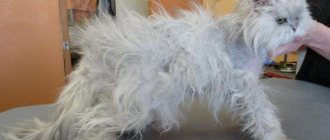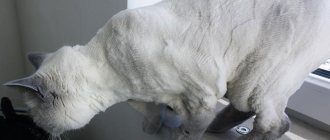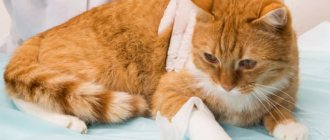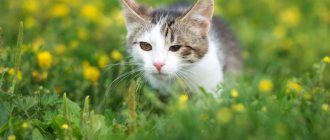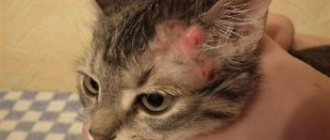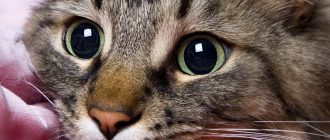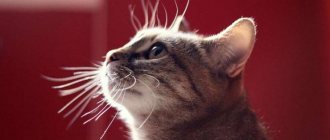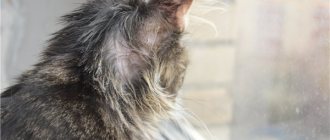Why do cats' tails become greasy?
Doctors still cannot give an exact answer to the question of why the cat has a greasy tail. But it has already been precisely established that purebred animals are especially prone to this (hence another name - “the tail of breeding cats”), and most often uncastrated male sires, although females can also get sick. Animals in cage-based nurseries and those that take poor care of their fur are more susceptible.
Excessive sebum production not only leads to an unpleasant appearance, but can also be complicated by the addition of secondary bacterial and fungal microflora, which leads to the development of inflammatory processes. At the same time, the fur in this area can change its color and fall out.
Drugs used
To successfully treat an animal, the use of any one remedy is not enough. Therapy must be comprehensive. Medicines should be used both internally, to suppress microflora, and locally.
Ointments
Ointments and liniments have a fatty base, which contributes to:
- rapid absorption of the active principle;
- preventing drying out of serous and mucous membranes;
- softening of tissues, as well as dried “crusts” and their rejection.
If there are no wounds or tears, there is no point in using ointments. Some substances can be absorbed through the skin, but no strong effect is felt.
If there is an abscess or purulent cavity, then applying ointments will help relieve inflammation, but at the same time it is necessary to remove the purulent masses and excise the pockets so that the contents do not linger.
The inconvenience of using ointments for the sub-tail area is that the cat sits down and wipes the ointment on the floor and bedding.
It’s a completely different matter when the drug “Olazol” is used. When shaking the bottle, a foamy mass forms. Through the nozzle it can be easily inserted into the lumen of the rectum. By doing this regularly, you can quickly create the necessary concentration of the active principle in the tissues and relieve inflammation. The base is chloramphenicol and sea buckthorn oil. The drug is effective for paraproctitis and the cat recovers quickly.
The following can be used as ointments:
- levomekol;
- levosin;
- chloramphenicol - gel;
- syntomycin liniment;
- gentamicin ointment.
The ointment should be applied at intervals of 1-2 hours into the wound cavity. If there is no wound, then apply the ointment alone to a cotton swab and insert it into the cat’s rectal cavity. You should change your tampon 2 times a day.
Antibiotics
A course of antibiotics is necessary to suppress the infection and lasts 5-7 days, depending on the severity of the process.
The most effective drugs are:
- cephalexin. If the drug is in capsules, then the gelatin base contains a powder that is very easy to dose. For an average cat, you can take 1/10 of it, mix it with minced meat and apply it to the root of the tongue. The tablet form is turned into powder or 1/10 of the tablet is broken off and served to the cat. The drug is well absorbed and retained in soft tissues and acts against many microorganisms. The drug is administered 2 times a day in a mixture with food;
- ciprafloxacin. The group of fluoroquinolones to which the drug belongs is able to quickly cope with the onset of infection and relieve inflammation from soft tissues. The drug is in tablet form. For a cat, the tablet is divided into 10 parts and placed in the mouth in one part in the morning and in the evening.
Rectal suppositories
The described pathology is localized in the rectum and the use of rectal suppositories is advisable.
The following drugs may be most effective:
- “Ichthyols”, based on ichthyol;
- “Propolis” containing propolis;
- "Proctosedil", with antibiotics and hydrocartisone
- "Olesthesin" with sulfonamides and sea buckthorn oil.
Suppositories are administered 2 times a day after bowel movements.
Greasy tail in a cat: how to diagnose
Although the symptoms of this disease are quite characteristic, and an experienced doctor does not raise doubts, it is often necessary to exclude the possibility of developing other diseases - lichen, neoplasms, skin mites.
This photo shows a cat's greasy tail. As you can see, the picture is very specific.
A veterinarian can make an accurate, 100% diagnosis only after a biopsy—taking a tiny piece of tissue for further examination under a microscope.
conclusions
These are the main reasons why a cat's fur may look greasy and unkempt. Some of them go away on their own; in other cases, veterinary intervention will be required. With competent actions by the owner, if oily fur is detected on a pet, the problem can be eliminated in just a few days, returning the animal’s fur to its former shine and beauty.
The problem of oily fur goes away within a few days with the correct actions of the owner.
Sebaceous tail treatment
The most exciting question is how to treat this unpleasant disease? Of course, it rarely affects the animal’s quality of life, but it can make the owner very nervous, especially when it comes to a breeding and valuable cat. Treatment can be divided into local and general.
Local treatment
Topical skin treatments can be very effective, but never completely solve the problem. However, we must admit that an integrated approach to caring for problematic tail skin will help reduce the manifestations of the disease to a minimum. To do this you need:
- Provide the animal with more space (if kept in a cage);
- Brush your cat regularly, especially the tail area.
- For washing, use a special shampoo - antiseborrheic agents with ethyl lactate or benzoyl peroxide help against greasy tail.
- Treat the skin surface with 1% salicylic alcohol and chlorhexidine.
In the absence of shampoo, for a short-term effect, some owners use degreasers, such as dishwashing detergent like Fairy, diluted with water in an average ratio of 3:1.
General treatment
The addition of secondary flora and inflammation of the skin on the tail should be accompanied by additional treatment. Your veterinarian will likely prescribe antibiotics for 3-4 weeks.
There is also an opinion that castration can nullify all manifestations of the disease. Although this fact has not been proven, because sometimes sebaceous tail occurs in sterilized animals, veterinarians suggest a connection between the level of sex hormones and hyperplasia of the tail gland.
Usually, castration allows you to completely get rid of the problem within 2 months, and progress does not occur only in rare cases.
Symptoms of the disease
It is believed that cats are more susceptible to this disease than others, but it can also occur in cats. Moreover, some breeds are more at risk than others of developing such an unpleasant and difficult-to-treat disease. For example, the Scottish Fold cat is often noted to have a hard tail, while according to breed standards its mobility is especially valued. With such a disorder, a “greasy tail” may also occur.
But the Persian cat is more susceptible to acne, which causes her not just discomfort, but can cause a serious illness. In addition, representatives of any breed, and even outbred cats, can have a fat tail.
In short-haired or “hairless” breeds, it is much easier to detect such a defect, but it is much more difficult to detect it in an animal with a luxurious, bushy tail. Most often, it is discovered by chance, when the process has already started and done its dirty deed.
Greasy tail syndrome is accompanied by the following symptoms:
- The fur at the base of the tail becomes very greasy, covered with thick secretions, which are very difficult or impossible to wash off using simple methods, at least from the first approach.
- On the skin at the base of the hairs you can see tubercles, which can be inflamed, covered with rough scales, and a purulent crust.
- When the disease is advanced, a whole scattering of inflamed pimples or scars from scratching may be found on the skin.
- When the fur suffers from greasy hair, it can break off at the base, leaving the affected area exposed or looking as if the hair has been clipped or pulled out.
- When the anal glands are inflamed, the animal tries to get rid of their excess contents by crawling with its backside on the floor, and sometimes on the carpet.
- With acne, a greasy yellowish spot first appears on a cat's fur, then a “black dot”, and in the absence of care and treatment, a hard crust forms, under which there may be an inflamed or abscessing acne.
INTERESTING TO FIND OUT: Is it necessary to treat trichobezoar in cats?
Having discovered such symptoms in their pet, the owner needs to contact a veterinarian, who will make a diagnosis and tell you how to deal with the disease.
Diseases associated with baldness
The most common diseases when a cat becomes bald around the tail are:
- Dermatomycoses. A group of fungal diseases. Symptoms: the coat becomes weak and easily falls off in the area of the tail, ears and back. The danger of diseases of this group is that they are quickly transmitted not only to animals, but also to people. Treatment is carried out using antifungal ointments and antibiotics.
- Skin diseases. The cause of bald areas can be the activity of parasites, infection, or allergies. The cat experiences unbearable itching in the area of baldness and furiously scratches the affected areas. Diseases bring a lot of suffering to a pet, so treatment should be carried out immediately using drops, shampoos, ointments prescribed by a doctor, after a full examination and determination of the cause of alopecia.
- Oily seborrhea. Disruption of the fat glands. Due to excess, or vice versa, lack of fat production, hair falls out profusely in the tail area. A complex of vitamin preparations is prescribed. The affected areas are treated with antiseptic solutions.
- Lack of vitamins. If small bald patches appear in the tail area, this may indicate that the pet lacks vitamins. It is necessary to include in your cat's diet primarily foods high in iron, calcium and phosphorus. Often, intense baldness is observed during pregnancy, as well as during lactation.
- Stress. Moving, changing owner, or environment can cause intense baldness in the tail area. This condition is accompanied by loss of appetite, irritability, and disturbances in the functioning of the digestive system. To get your pet out of a stressful state, you need to pay more attention, care and affection. Anti-stress medications are prescribed.
Effective results are achieved by using decoctions of calendula, chamomile, and oak bark, if combined with medications. If you lubricate the affected areas of the skin with an infusion of herbs, this will significantly speed up the healing process.
In some cases, if a cat's tail is bald at the base, the cause is hormonal disorders after sterilization, as well as tick and flea bites. After examination and diagnosis, concomitant treatment is prescribed aimed at eliminating the causes of baldness and combating the primary disease. The animal is simultaneously prescribed a special diet and a complex of vitamins to support the immune system.
